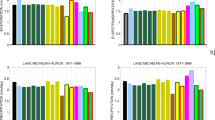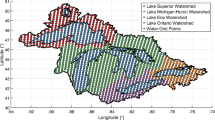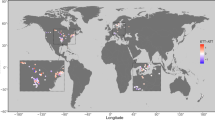Abstract
Historical climates, based on 43 years of daily data from areas south and southwest of the Great Lakes, were used to examine the hydrological response of the Great Lakes to warmer climates. The Great Lakes Environmental Research Laboratory used their conceptual models for simulating moisture storages in, and runoff from, the 121 watersheds draining into the Great Lakes, over-lake precipitation into each lake, and the heat storages in, and evaporation from, each lake. This transposition of actual climates incorporates natural changes in variability and timing within the existing climate; this is not true for General Circulation Model-generated corrections applied to existing historical data in many other impact studies. The transposed climates lead to higher and more variable over-land evapotranspiration and lower soil moisture and runoff with earlier runoff peaks since the snow pack is reduced up to 100%. Water temperatures increase and peak earlier. Heat resident in the deep lakes increases throughout the year. Buoyancy-driven water column turnover frequency drops and lake evaporation increases and spreads more throughout the annual cycle. The response of runoff to temperature and precipitation changes is coherent among the lakes and varies quasi-linearly over a wide range of temperature changes, some well beyond the range of current GCM predictions for doubled CO2 conditions.
Similar content being viewed by others
References
Assel, R. A., Quinn, F. H., Leshkevich, G. A., and Bolsenga, S. J.: 1983, Great Lakes Ice Atlas, Great Lakes Environmental Research Laboratory, Ann Arbor, MI, p. 115.
Coordinating Committee on Great Lakes Basic Hydraulic and Hydrologic Data: 1977, Coordinated Great Lakes Physical Data, U.S. Army District Engineer, Detroit, p. 33.
Croley, T. E., II: 1983a, ‘Great Lakes Basins (U.S.A.-Canada) Runoff Modeling’, J. Hydrol. 64, 135-158.
Croley, T. E., II: 1983b, ‘Lake Ontario Basin (U.S.A.-Canada) Runoff Modeling’, J. Hydrol. 66, 101-121.
Croley, T. E., II: 1989, ‘Verifiable Evaporation Modeling on the Laurentian Great Lakes’, Water Resour. Res. 25(5), 781-792.
Croley, T. E., II: 1990, ‘Laurentian Great Lakes Double CO2 Climate Change Hydrological Impacts’, Clim. Change 17, 27-47.
Croley, T. E., II: 1992, ‘Long-Term Heat Storage in the Great Lakes’, Water Resour. Res. 28, 69-81.
Croley, T. E., II: 1993, ‘Probabilistic Great Lakes Hydrology Outlooks’, Water Resour. Bull. 29, 741-753.
Croley, T. E., II: 1994, ‘Hydrological Impacts of Climate Change on the Laurentian Great Lakes’, in Trends in Hydrology, Vol. 1, Council of Scientific Research Integration, Research Trends, Kaithamukku, Trivandrum, India, pp. 1-25.
Croley, T. E., II: 1995, ‘Laurentian Great Lakes Dynamics, Climate, and Response to Change’, in Oliver, H. R. and Oliver, S. A. (eds.), The Role of Water and the Hydrological Cycle in Global Change, Proceedings of the NATO Advanced Study Institute, NATO ASI Series 1: Global Environmental Change, Vol. 31, SpringerVerlag, Berlin, pp. 251-296.
Croley, T. E., II and Assel, R. A.: 1994, ‘A One-Dimensional Ice Thermodynamics Model for the Laurentian Great Lakes’, Water Resour. Res. 30, 625-639.
Croley, T. E., II and Hartmann, H. C.: 1987, ‘Near-Real-Time Forecasting of Large Lake Supplies’, J. Water Resour. Plann. Manage. Div. 113, 810-823.
Croley, T. E., II and Hartmann, H. C.: 1989, ‘Effects of Climate Changes on the Laurentian Great Lakes Levels’, in Smith, J. B. and Tirpak, D. A. (eds.), The Potential Effects of Global Climate Change on the United States: Appendix A - Water Resources, U.S. Environmental Protection Agency, Washington, D.C., pp. 41-434.
Croley, T. E., II and Lee, D. H.: 1993, ‘Evaluation of Great Lakes Net Basin Supply Forecasts’, Water Resour. Bull. 29, 267-282.
Croley, T. E., II, Quinn, F. H., Kunkel, K. E., and Changnon, S. A.: 1996, Climate Transposition Effects on the Great Lakes Hydrologic Cycle, NOAA Technical Memorandum ERL GLERL89, Great Lakes Environmental Research Laboratory, p. 100.
Hartmann, H. C.: 1990, ‘Climate Change Impacts on Laurentian Great Lakes Levels’, Clim. Change 17, 49-67.
Kunkel, K. E., Changnon, S. A., Croley, T. E., II, and Quinn, F. H.: 1998, ‘Transposed Climates for Study of Water Supply Variability on the Laurentian Great Lakes’, Clim. Change 38, 387-404.
Quinn, F. H. and den Hartog, G.: 1981, ‘Evaporation Synthesis’, in Aubert, E. J. and Richards, T. L. (eds.), IFYGL - The International Field Year for the Great Lakes, National Oceanic and Atmospheric Administration, Ann Arbor, MI, pp. 221-245.
Author information
Authors and Affiliations
Rights and permissions
About this article
Cite this article
Croley II, T.E., Quinn, F.H., Kunkel, K.E. et al. Great Lakes Hydrology Under Transposed Climates. Climatic Change 38, 405–433 (1998). https://doi.org/10.1023/A:1005344010723
Issue Date:
DOI: https://doi.org/10.1023/A:1005344010723




